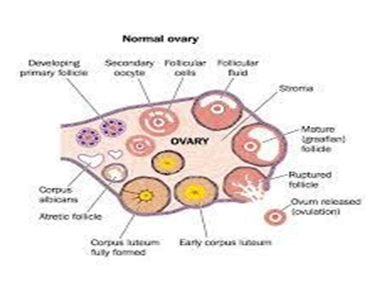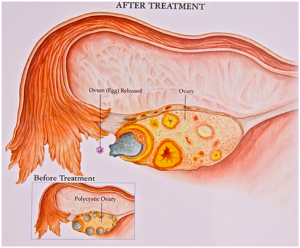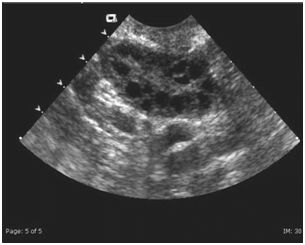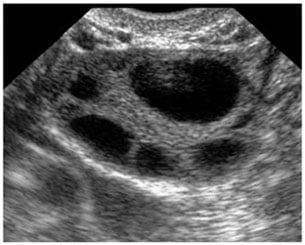

The first step of treating infertility in many cases is to treat the underlying cause of infertility. For example, in cases where thyroid disease or increase in prolactin levels causes hormone imbalances, medication for normalizing hormonal levels can trigger ovulation.
In case of shorter duration of Infertility, in young couple with normal reports, follicular monitoring can be done in the natural cycle and timed intercourse can be advised.
Physiology of follicular growth & ovulation.
Journey to ovulation begins during the late luteal phase of the prior menstrual cycle. Dominant follicles are selected from 2-5mm follicles in previous cycle luteal phase. This process is called ‘recruitment’. The antral follicular count indicates ovarian reserve which reduced with advanced age and prior treatment.
During Day 1-5 of the menstrual cycle, a process of ‘follicular selection’ begins, when among all recruited follicles, certain growing follicles of size 5-10 mm are selected, remaining follicles regress.
During Day 5-7 of the menstrual cycle, a process of ’dominance’ begins. The single follicle of 10mm becomes dominant. It’s more sensitive to hormonal stimulation. The growth of the rest of the follicles is suppressed.
A dominant follicle is destined for ovulation. This follicle starts growing at a rate of 1.5-2 mm a day and reaches 18-20mm size just prior to ovulation.
Almost nearing ovulation, rapid follicle growth takes place, and follicle starts protruding from the ovarian cortex. At the time of ovulation, the follicle ruptures releasing fluid and oocyte.
Ovulation induction means giving medicines and/or injections to help one follicle grow and subsequently rupture. Ovulation induction is useful for women with anovulatory infertility such as PCOS and irregular cycles.
Ovulation Stimulation is growing more than one egg to get better quality eggs or thicker uterine lining so that the chances of pregnancy are better. Used mostly in IVF ICSI.
Ovulation induction can be coupled up with IUI also.


Clomiphene is medication patient take by mouth (orally).
Clomiphene is a weak estrogen-like hormone that acts on the hypothalamus and pituitary gland, blocks estrogen receptors and increase levels of follicle-stimulating hormone (FSH).
An increased level of FSH hormones causes the growth of multiple follicles.
In women who ovulate irregularly, approximately 80 percent who take clomiphene will ovulate, and 30 to 40 percent of all women who take clomiphene become pregnant. This statistics is calculated after 3 subsequent cycles of induction.
Clomiphene resistance defined as a failure to ovulate after receiving 150 mg of CC daily for 5 days per cycle, for at least three cycles, is common and occurs in approximately 20-25% in women with PCOS.
If a woman does not become pregnant after taking clomiphene for six menstrual cycles, gonadotropins can be added for better results.
Use of clomiphene increases the risk of having multiple pregnancies. Twins gestation is comer than triplets or more —less than 1% of cases.
Gonadotropins are hormones( FSH and LH) that are injected to directly stimulate eggs from ovaries, leading to ovulation. Gonadotropins are started when a woman does not respond to clomiphene or to stimulate follicle growth for IUI or IVF.
• Gonadotropins are injected starting on day 2 or day 3 of the menstrual cycle for 7 to 12 days.
• Gonadotropins can be given in combination with clomiphene citrate.
• Transvaginal ultrasound is used to monitor the size of the developing follicles containing eggs.
• The chance of multiple births is higher with gonadotropins than with clomiphene, About two-thirds of multiple births are twins. Triplets or larger multiple births account for the remaining third.
hCG is given on complete growth of follicles. It acts as Leutinising Hormone analogue causing rupture of follicle and egg release.
Follicular Monitoring by transvaginal ultrasonography is used to monitor the growth of the ovarian follicles. It is useful for assessing the size of the follicle that supports the growing egg and for determining the thickness of the uterine lining.




Transvaginal ultrasound is an integral part of infertility treatment.
The first scan is done on day 2 or 3 of the cycle:
• To assess a baseline ovarian size, ovarian volume in three dimensions. Ovarian volume less than 3cc indicates low reserve and more than 10cc in absence of cystic lesion is suggestive of polycystic ovaries.
• To count the number of antral follicles available. Starting dose of medication can be decided depending on ovarian volume and antral follicular count.
• To rule out the presence of cyst from the previous cycle.
• Ovarian stromal blood flow has been recommended as a good predictor of ART success. Increased peak systolic velocity (>10 cm/sec) is one of such parameters which has been advocated.
As the study progresses on day 9, dominant follicle is evident to be growing. In the case of ovarian stimulation by medicine or hormones, more than one follicles can start to develop.
Dose of hormonal preparations can be decided depending upon ovarian response.
Endometrial thickness is measured along with follicular monitoring.
Once the follicle reaches 18-20mm ovulation can be expected.
Follicle suddenly vanishes or regresses in size.
• Irregular margins.
• Intra-follicular echoes. Follicle suddenly becomes more echogenic.
• Free fluid in the pouch of Douglas.
• On Doppler increased perifollicular blood flow velocities.
In the absence of spontaneous ovulation, hCG or Lupride can be given for ovulation.
On documentation of ovulation, a couple is advised for planned relations or IUI considering other factors as age, duration of infertility, semen analysis.